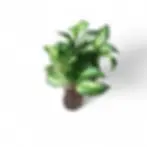Peperomia 'Hovaria' – felted succulent peperomia with soft grey leaves
Peperomia 'Hovaria' is a rare and unusual selection, most likely a hybrid or cultivar related to Peperomia incana, though its exact origin is unconfirmed. It differs from many compact Peperomia by producing long, branching, fleshy stems with large, round, grey-green leaves. Covered in a fine down, the foliage has a velvety texture that sets this plant apart from other members of the genus.
● Growth and features of Peperomia 'Hovaria'
This plant develops sprawling to semi-trailing stems, making it suitable for larger pots or hanging displays. The leaves are orbicular, slightly concave, and felted with short hairs, giving them a soft, tactile surface. Their muted grey-green tones add an architectural, almost desert-like quality. Slender flower spikes may appear in maturity, but the foliage remains the main attraction.
● Background and naming
The exact breeding history of 'Hovaria' is unclear. It is most frequently linked to Peperomia incana (Haw.) Hook., a species native to Brazil known as the felted peperomia. Its name is used in horticultural trade but is not tied to a formally registered cultivar. Collectors value it for its unusual growth habit and distinctive felted leaves.
● Care guide for Peperomia 'Hovaria'
- Light: Prefers bright, indirect light; tolerates some direct morning or evening sun.
- Watering: Water moderately, letting the top 3 – 4 cm of soil dry before watering again. Avoid prolonged wetness.
- Humidity: Average indoor humidity (40 – 60%) is sufficient; tolerant of drier air compared to many Peperomia.
- Temperature: Keep between 18 – 26 °C; protect from cold drafts below 15 °C.
- Soil: Use a gritty, free-draining substrate, similar to a cactus or succulent mix.
- Feeding: Apply diluted, balanced fertilizer every 4 – 6 weeks during active growth.
● Common issues with Peperomia 'Hovaria'
Overwatering is the main cause of decline, often leading to root or stem rot. Too little light may cause stretched, leggy growth. Leaves may wrinkle when the plant is under-watered but usually recover quickly once rehydrated.
● Notes for collectors
‘Hovaria’ is uncommon in cultivation and sought after by collectors of succulent Peperomia. Its velvety, grey-green leaves and trailing habit distinguish it from typical compact ripple peperomias. Best displayed in hanging pots or elevated containers where its branching stems can cascade naturally.
● Etymology of Peperomia
The genus name Peperomia was established in 1794 by Spanish botanists Hipólito Ruiz López and José Antonio Pavón Jiménez. It derives from Greek peperi (“pepper”) and homoios (“resembling”), referring to its relationship to black pepper (Piper nigrum).
● Questions about Peperomia 'Hovaria'
How large does it grow?Stems may trail or sprawl up to 30 – 40 cm, depending on care and conditions.
Is it safe for pets?Yes, Peperomia species are generally considered non-toxic to cats and dogs.
What makes 'Hovaria' unique?Its felted grey-green leaves and sprawling habit make it stand out from compact peperomia cultivars.
● Add Peperomia 'Hovaria' to your collection
With its velvety, silver-grey leaves and unusual trailing habit, Peperomia 'Hovaria' is a rare find for collectors of succulent houseplants. Order today to secure this distinctive, easy-care addition to your collection.
Peperomia 'Hovaria'
Peperomia 'Hovaria' is approximately 40 cm tall and comes in a ⌀ 15 cm pot.






























